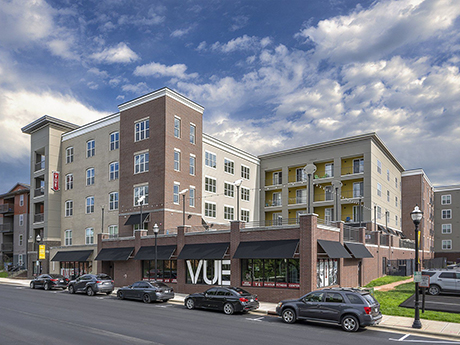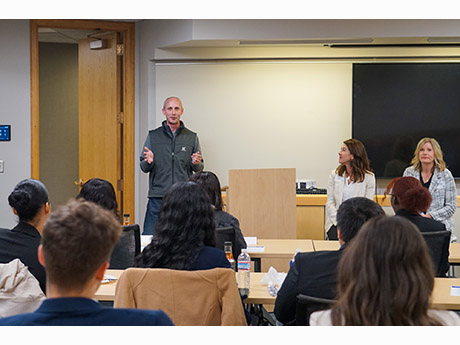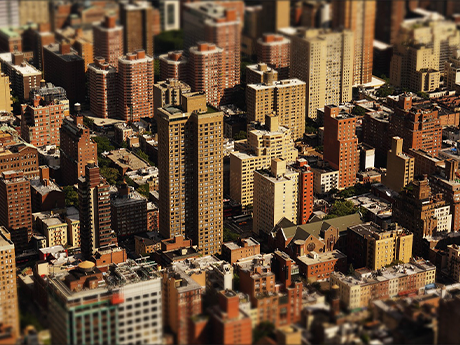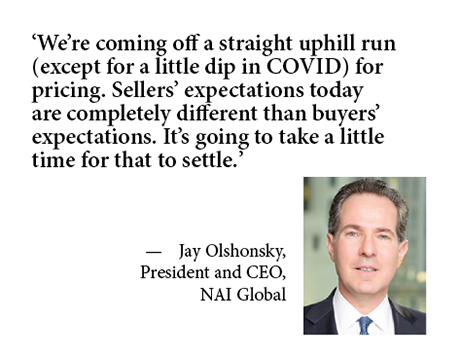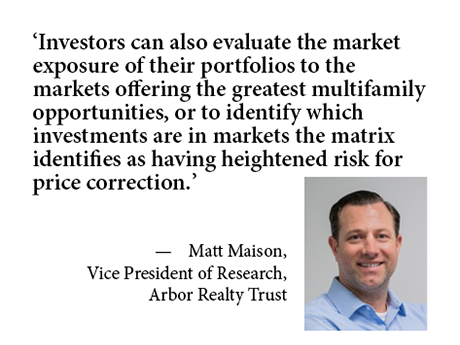The cancellation of the NMHC Student Housing Conference due to Hurricane Ian took some wind out of the student housing investment sales market this fall. The annual event is where many dealmaking meetings are held. Activity was a little slower during the third quarter due to changes in the capital markets climate, but is expected to pick up as the year draws to a close and more sellers bring properties to market. “August was a little bit slower, but now that we have the rent rolls for fall 2022 we are seeing a lot of assets hit the market,” says Teddy Leatherman, senior managing director, capital markets, with JLL. “Our team has never been busier from a broker’s opinion of value (BOV) or RFP standpoint.” The investment sales market, overall, has had a strong year. Even removing Blackstone’s $13 billion acquisition of American Campus Communities from the market, the student housing sector has had a robust year. Add that transaction in the mix, and the industry will likely have a record year in 2022. “The first three quarters of 2022 surpassed 2021’s volume and broke 2018’s record for annual transaction volume,” says Timothy Bradley, founder of TSB Capital Advisors and …
Features
Delayed Payments Result in $208B Cost Impact for U.S. Construction Industry in 2022, New Report Reveals
by Jeff Shaw
AUSTIN, TEXAS — Delayed payments for wages and invoices are projected to represent an estimated $208 billion in excess costs to the construction industry this year, up 53 percent from $136 billion in 2021, according to a newly released report from Rabbet, an Austin-based construction finance software provider. Rabbet’s 2022 Construction Payments Report surveyed 137 general contractors and subcontractors across the U.S. about the speed of payments in the industry and examined the growing impact on the cost for the broader sector. The report studied how general contractors and subcontractors across the country managed working capital, bidding decisions and project risks in the face of slow payments during the last 12 months. The survey was conducted online in September. Forty-nine percent of subcontractors reported that over the past 12 months, they waited longer than 30 days on average to receive payment from general contactors. Thirty-seven percent of respondents indicated that work had been delayed or stopped in the last 12 months due to delays in payments to crew members, up from 28 percent in 2021. Additionally, 27 percent of subcontractors reported having filed a lien in the last 12 months to keep possession of a property until their firm received payment …
Content PartnerDevelopmentFeaturesIndustrialMidwestMixed-UseMultifamilyNortheastNorthmarqOfficeRetailSoutheastTexasWestern
Project Destined: Training a New and Diverse Generation for Real Estate Careers
For the better part of the last two decades, billions of dollars have poured into underserved neighborhoods across the U.S. as corporations, millennials and real estate investors rediscovered downtowns and other urban districts. But to former Carlyle Group executive Cedric Bobo and real estate entrepreneur Fred Greene, young people who grew up in the neighborhoods were often excluded from playing a role in the transitions. To remedy that problem, in 2016 they began training 15 Detroit high school students in real estate fundamentals and invested $150,000 to buy two properties with the idea of using the cash flow to fund scholarships. Soon after, Bobo and Greene officially launched Project Destined, an endeavor to effect social change in the commercial real estate industry by providing college students with financial literacy, entrepreneurship and real estate training. “Cedric found that there was a real need for diverse talent in commercial real estate but that it was hard for companies to find it,” reports Cristina Ciacciarelli, a junior at Burach College in New York City who completed the program in 2021 and now heads up corporate partnerships for Project Destined. “It was also hard for the companies to sell themselves to diverse talent even …
By Blair Sweeney, managing director, Landmark Properties More Americans are looking for homes even as available housing shrinks. This dynamic is rapidly accelerating the demand for build-to-rent (BTR) communities. The United States has failed to build as many homes as needed to keep up with population expansion, especially in markets in and around growing cities. Over the past 10 years, U.S. developers have delivered 19 percent less housing than in the previous decade — all while the population and overall demand for housing dramatically increased. The challenges to adding housing inventory aren’t new. In many areas, it’s become very difficult and expensive to navigate environmental and zoning regulations, putting many otherwise available sites out of reach. Additionally, costs of materials and labor continue to rise. While these constraints existed before the pandemic, COVID-19 pulled these limitations forward. Emerging in response to the agitated real estate market are single-family homes that are developed specifically as rentals, a relatively new housing product type that combines elements of homeownership and multifamily renting. Unlike institutional investors purchasing existing single-family homes off the market to rent, Landmark Properties is purpose-building homes to combat the nation’s housing shortage, ultimately alleviating pricing pressure in the housing market. …
WASHINGTON, D.C. — The Federal Reserve last Wednesday raised the benchmark short-term borrowing rate by another 0.75 percentage point to a target range of 3.75 to 4 percent. The move by the central bank marked the sixth time this year that it has raised the fed funds rate, which now stands at its highest level since January 2008. The series of rate hikes is part of an aggressive effort by the Federal Reserve to combat inflation, which reached a 40-year high of 9.1 percent in June on a year-over-year basis and has held at elevated levels in the ensuing months. Inflation came in at 8.2 percent in September. The high interest rates have had a notably negative impact on the multifamily sector, according to the data from the National Multifamily Housing Council (NMHC), based out of Washington, D.C. Four indices in the trade association’s latest Quarterly Survey of Apartment Conditions came in below the breakeven level, loosely defined as the point at which there is no change in market conditions. The latest findings were based on the responses of 268 CEOs and other senior executives of apartment-related firms nationwide. The survey was conducted Oct. 17-24. “The Fed’s continued interest rate hikes have resulted in …
Content PartnerFeaturesIndustrialLeasing ActivityLoansMidwestMultifamilyNAINortheastOfficeRetailSoutheastTexasWestern
Experts Turn to Opportunistic Moves, Lending During Uncertainty of Economic Downturn
As we shift through economic uncertainty and changes in the market, commercial real estate businesses are planning for a range of scenarios — and looking to historical trends to make predictions. REBusinessOnline sat down with two industry experts to talk about how this period of uncertainty compares to previous eras and where there may be benefits and opportunities in the current landscape. Jay Olshonsky, president and CEO, and Cliff Moskowitz, executive vice president, at NAI Global spoke about the commercial real estate outlook and the challenges it is likely to face in the immediate future. REBusiness: Looking at the current environment, how does it compare to previous periods of uncertainty? What might be the impacts on commercial real estate? Olshonsky: To start with, we are in a recession. We’ve already had two quarters of negative GDP growth. I think the most fundamental difference between this cycle and a lot of other cycles is that we have extremely low unemployment, differentiating this moment from others, for example, 2009. Even though the most recent job numbers were lower, they were still fairly strong. Jobs create the demand for commercial real estate at all levels, but especially at the services level. We do …
AcquisitionsContent PartnerDevelopmentFeaturesIndustrialLeasing ActivityLee & AssociatesMidwestMultifamilyNortheastOfficeRetailSoutheastTexasWestern
Lee & Associates’ Third-Quarter 2022 Economic Rundown by Sector
Lee & Associates’ newly released 2022 Q3 North America Market Report examines third-quarter 2022 industrial, office, retail and multifamily outlooks throughout the United States. This sector-based review of commercial real estate trends for the third quarter of the year examines the difficulties facing each asset class and where opportunities in the commercial real estate landscape may be emerging. Lee & Associates has made the full market report available here (with further breakdowns of factors like vacancy rates, market rents, inventory square footage and cap rates by city), but the summaries below provide high-level considerations of the overall health and obstacles for the industrial, office, retail and multifamily sectors. Industrial Overview: High Rent, Low Vacancy Everywhere North American industrial space availability is tight everywhere while rent growth and property prices remain near or have moved beyond historic highs. Through the third quarter, the United States’ vacancy rate settled at 4 percent, up 10 basis points from second quarter 2022. Average rents increased 11.4 percent year over year with gains of 19 percent in Miami, 18.7 percent in Southern California’s Inland Empire, 16 percent in Phoenix and 14.6 percent in Atlanta. Since the COVID lockdown in March of 2020, developers of U.S. logistics space have been …
Sun Belt Markets Dominate Top 10 ‘Markets to Watch’ in 2023, According to Emerging Trends Report
by John Nelson
WASHINGTON, D.C. — A variety of Sun Belt markets once again lead the “top markets to watch” in 2023 for overall real estate prospects, with Nashville ranking No. 1 for the second consecutive year in the annual Emerging Trends report issued by the Urban Land Institute (ULI) and PwC US. Using proprietary data and insights from more than 2,000 real estate industry experts across 80 tracked markets in the United States and Canada, Emerging Trends pegged the Music City as a “supernova” market due to its evolution from an 18-hour city to a “24-hour metropolis.” In the past couple years, Nashville has attracted Amazon and Oracle to build new office campuses, and two weeks ago the NFL’s Tennessee Titans and the Metropolitan Government of Nashville and Davidson County agreed to terms for a new $2.1 billion football stadium in the East Bank district that could attract events such as the Super Bowl and College Football Playoff. The private investment is in response to the Nashville MSA posting a 21 percent population growth rate in the past decade, according to the latest U.S. Census data. The Emerging Trends report noted that the pandemic has reinforced these migration trends as workers from …
Executive Q&A: Multifamily Building Costs Rise Up to 40 Percent in a Year, Says R&O Construction’s Eric Stratford
by Jeff Shaw
OGDEN, UTAH — Multifamily builders face many challenges, including schedule delays, supply chain interruptions, fluctuating material costs and workforce shortages. Construction companies are exercising creativity in tackling these issues to meet high demand. Many firms that build commercial properties argue that smart planning and collaboration among architects, engineers and construction firms are the best ways to weather the storm. REBusinessOnline, a sister publication of Multifamily & Affordable Housing Business, recently interviewed Eric Stratford, director of business development and pre-construction services at R&O Construction, about today’s construction landscape. REBusinessOnline: Tell us about your company. Eric Stratford: R&O Construction was founded in 1980, and we are proud to say that our first client over 42 years ago is still a client today. We are headquartered in Ogden, Utah, with full-service offices in Salt Lake City and Las Vegas. R&O Construction currently employs approximately 185 employees. Some of our recent projects include Senior Living on Washington, an affordable seniors housing community in Ogden; Ascent 1791, a LEED Gold Certified apartment community in Park City, Utah; and The Canyons Employee Housing Facility, a project ordered by Vail Resorts to provide housing for their employees. REBusinessOnline: In which markets and/or regions are you most active? …
AcquisitionsArbor Realty TrustContent PartnerFeaturesMidwestMultifamilyNortheastSoutheastTexasWestern
Multifamily Opportunity Matrix Reveals Most Promising Markets for Investors, Developers
By Arbor Realty Trust Inflationary environments set many investors’ minds to thinking about multifamily properties, which have tended to perform as well or better than other property types in the face of economic headwinds. Product type is no guarantee of success, however, and careful site selection is essential to ensure a project will have the renter demand and pricing power the owner needs to succeed. Arbor Realty Trust, in partnership with Chandan Economics, developed the opportunity matrix featured in Arbor’s Top Opportunities in Large Multifamily Investment Report 2022. The opportunity matrix helps clients navigate the nation’s apartment markets, enabling them to compare relative strengths from one metro to the next and identify those offering the greatest potential for development or investment. Its ranking system, which analyzes eight key categories, found the top three U.S. metro markets for large multifamily investment in 2022 are San Antonio, Kansas City and Las Vegas. “Reviewing what made these communities rise to the top of our 50-metro ranking will demonstrate how investors can use the matrix to compare the climates of opportunity in the markets in which they operate, or to suggest new fields of opportunity for their next venture,” said Matt Maison, vice president …


